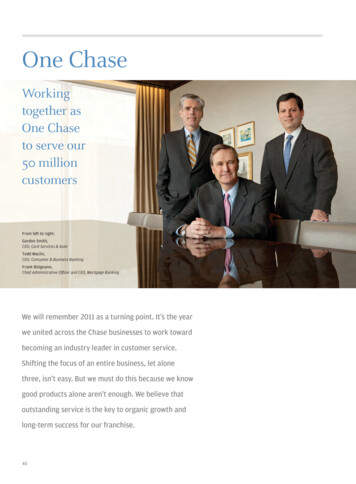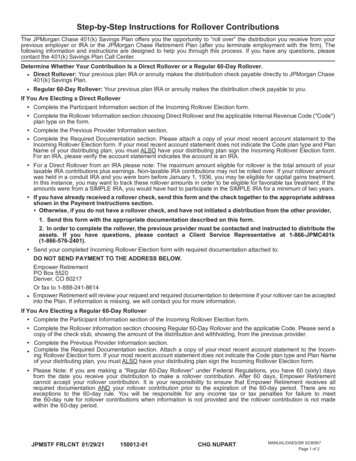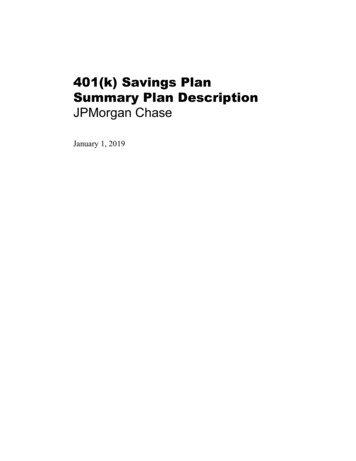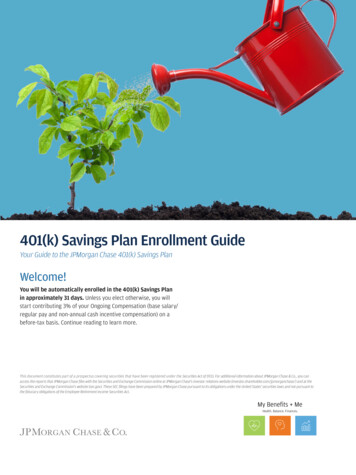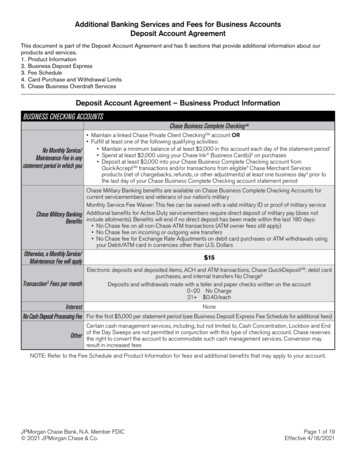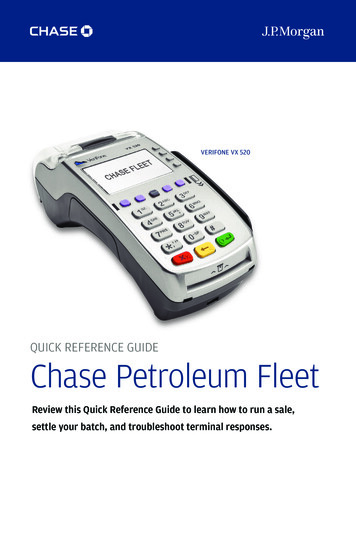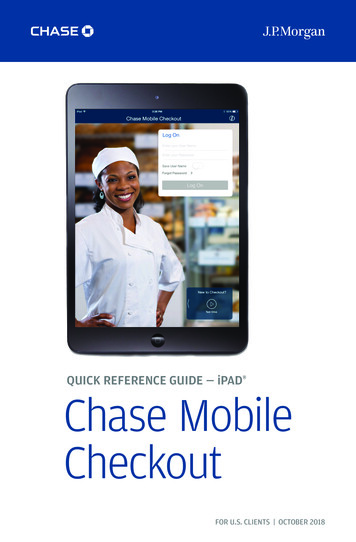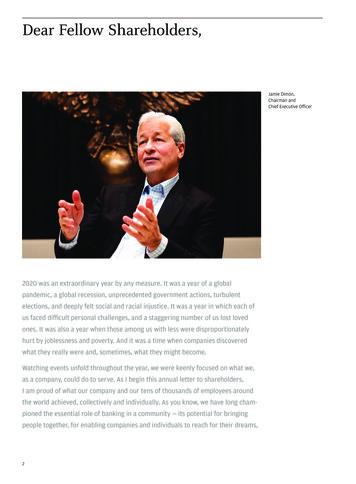
Transcription
Dear Fellow Shareholders,Jamie Dimon,Chairman andChief Executive Officer2020 was an extraordinary year by any measure. It was a year of a globalpandemic, a global recession, unprecedented government actions, turbulentelections, and deeply felt social and racial injustice. It was a year in which each ofus faced difficult personal challenges, and a staggering number of us lost lovedones. It was also a year when those among us with less were disproportionatelyhurt by joblessness and poverty. And it was a time when companies discoveredwhat they really were and, sometimes, what they might become.Watching events unfold throughout the year, we were keenly focused on what we,as a company, could do to serve. As I begin this annual letter to shareholders,I am proud of what our company and our tens of thousands of employees aroundthe world achieved, collectively and individually. As you know, we have long championed the essential role of banking in a community — its potential for bringingpeople together, for enabling companies and individuals to reach for their dreams,2
and for being a source of strength in difficult times. Those opportunities werepowerfully presented to us this year, and I am proud of how we stepped up.I discuss these themes later in this letter.As I look back on the last year and the last two decades — starting from my timeas CEO of Bank One in 2000 — it is remarkable how much we persevered and haveaccomplished, not only in terms of financial performance but also in our steadfast dedication to help clients, communities and countries throughout the world.2020 was another strong year for JPMorgan Chase, with the firm generating recordrevenue, as well as numerous other records in each of our lines of business. Weearned 29.1 billion in net income on revenue of 122.9 billion versus 36.4 billionon revenue of 118.5 billion in 2019, reflecting strong underlying performance acrossour businesses offset by additional reserves under new accounting rules. We generally grew market share across our businesses and continued to make significantinvestments in products, people and technology, all while maintaining creditdiscipline and a fortress balance sheet. In total, we extended credit and raised 2.3 trillion in capital for businesses, institutional clients and U.S. customers.JPMorgan Chase stock is owned by large institutions, pension plans, mutual fundsand directly by individual investors. However, it is important to remember thatin almost all cases, the ultimate beneficiaries are the individuals in our communities. More than 100 million people in the United States own stock, and a largepercentage of these individuals, in one way or another, own JPMorgan Chase stock.Many of these people are veterans, teachers, police officers, firefighters, healthcare workers, retirees or those saving for a home, school or retirement. Yourmanagement team goes to work every day recognizing the enormous responsibilitythat we have to perform for our shareholders.While we don’t run the company worrying about the stock price in the short run, inthe long run our stock price is a measure of the progress we have made over theyears. This progress is a function of continual investments in our people, systemsand products, in good and bad times, to build our capabilities. Whether looking3
TYPESET; 3/16/21; v.21 JD earnings diluted 03Earnings, Diluted Earnings per Share and Return on Tangible Common Equity2004–2020( in billions, except per share and ratio data) 36.4 32.5Adjusted net income1 10.72 29.1 26.9 24.424% 19.0 17.415% 14.4 15.410% 8.5 4.00 4.336% 5.6 2.35 4.5 1.5215%15% 11.710%15% 5.19 4.4820072008 9.00 8.88 17.911% 6.00 6.1913%13%13% 5.29 6.3119%17%14%12% 4.34 3.96 2.264/6/21 r2 4:50pm 1.3520042005200621 JD TBVPS 02 24.4 21.7 21.322% 24.7Footnotes adjusted for style2009201020112012201320142015201620172018Net income Diluted earnings per share Return on tangible common equity (ROTCE)20192020AdjustedROTCE1 was13.6%for 20171 Adjusted net income, a non-GAAP financial measure, excludes 2.4 billion from net income in 2017 as a result of the enactment of the Tax Cuts and Jobs Act.TYPESET; 3/09/2021; v.21 JD TBVPS 02Tangible Book Value and Average Stock Price per Share2004–2020High: 141.10Low: 76.91 110.72 113.80 106.52 92.01 58.17 38.70 15.3520044 43.93 16.45 18.8820052006 51.88 47.75 39.83 36.07 63.83 65.62 21.96 22.5220072008 35.49 27.092009 40.36 39.36 30.122010 33.622011 39.22 38.68 40.7220122013 44.602014 48.132015 51.44 53.5620162017 56.332018 60.982019 66.112020
TYPESET; 3/9/21 v. 21 JD Stock Total Return 023/9/21 r1Stock total return analysisBank OneS&P 500 IndexS&P Financials Index11.9%928.1%6.5%268.0%4.1%128.8%JPMorgan Chase & Co.S&P 500 IndexS&P Financials (1.8)%11.1%10.8%Performance since becoming CEO of Bank One(3/27/2000—12/31/2020)1Compounded annual gainOverall gainPerformance since the Bank Oneand JPMorgan Chase & Co. merger(7/1/2004—12/31/2020)Compounded annual gainOverall gainPerformance for the period endedDecember 31, 2020Compounded annual gain/(loss)One yearFive yearsTen years(5.5)%17.2%14.7%These charts show actual returns of the stock, with dividends reinvested, for heritage shareholders of Bank One and JPMorgan Chase & Co.vs. the Standard & Poor’s 500 Index (S&P 500 Index) and the Standard & Poor’s Financials Index (S&P Financials Index).1 On March 27, 2000, Jamie Dimon was hired as CEO of Bank One.back over five years, 10 years or since the JPMorgan Chase/Bank One merger(approximately 15 years ago), these investments mean our stock has significantlyoutperformed the Standard & Poor’s 500 Index and the Standard & Poor’sFinancials Index. These important investments will also drive our company’sfuture prospects and position it to grow and prosper for decades.We have consistently described to you, our shareholders, the basic principles andstrategies we use to build this company — from maintaining a fortress balancesheet, constantly investing, nurturing talent, fully satisfying regulators, andcontinually improving risk, governance and controls to serving customers andclients while lifting up communities worldwide.Adhering to these principles allows us to drive good organic growth and properly manage our capital (including dividends and stock buybacks), which we haveconsistently demonstrated over the past decades. All of this is shown in the chartsin this introduction. In addition, we urge you to read the CEO letters in this AnnualReport, which will give you a lot more specific detail about our businesses and whatour plans are for the future.5
21 JD client franchises 124/6/21 r2 4:50pmFootnotes adjusted for style(TYPESET; 4/6/21r2 v. 21 JD client franchises 12Client Franchises Built Over the Long Term2006Consumer &CommunityBankingCorporate &InvestmentBankCommercialBankingAsset & WealthManagementActive digital customers (M)4.9Active mobile customers (M)—Active mobile customers growth rateNM% of digital payment transactions1 25%% of digital payment volume1 30%# of branches3,079Average Consumer Banking deposits ( B)2 152Average Business Banking deposits ( B) 37Average Consumer & Business Bankingdeposits ( B) 189Average Business Banking loans ( B) 13Client investment assets ( B) 80Deposits market share33.6%# of top 50 Chase markets where weare #1 (top 3)11 (25)Business Banking primary market share45.1%Credit card sales ( B) 257Debit card sales ( B)NADebit & credit card sales volume ( B)NACredit card loans ( B, EOP) 153Credit card sales market share516%202052.537.312%64%58%4,976 548 13655.340.910%72%62%4,908 657 175 684 24 5019.3% 833 38 5909.8%14 (40)9.4% 763 352 1,114 16922%14 (41)9.5% 703 379 1,081 14422%#18.9%#111.4%#111.6%co–#111.0% 26.8 465 7#19.2%#112.9%#113.1%co–#112.3% 31.0 611 8 Serve 63 million U.S. households including4.3 million small business relationships 55 million active digital customers6, including 41million active mobile customers7 #1 primary bank within Chase footprint8 #1 U.S. credit card issuer based on sales andoutstandings9 #4 mortgage servicer10 #2 bank auto lender11 Provided customer assistance to 2.0M accounts,representing balances of 83B12 #1 PPP lender on a dollar basisGlobal investment banking fees13Market share13Total Markets revenue14Market share14FICC14Market share14Equities14Market share14Assets under custody ( T)Average deposits ( B)15Daily payment processing ( T)16Average daily security purchases andsales ( T)Average total deposits ( B)#28.7%#86.3%#77.0%#85.0% 13.9 190NANANA 2.3 516 2.7 655# of top 75 MSAs with dedicated teamsBankersNew relationships (gross)Average loans ( B)Average deposits ( B)Gross investment banking revenue ( B)20Multifamily lending21361,203NA 53.6 73.6 0.7#28672,1011,706 207.9 172.7 2.7#1672,0201,856 218.9 237.8 3.3#1 1 37 locations across the U.S. and 30 internationallocations Credit, banking and treasury services to 18KCommercial & Industrial clients22 and 33K real estateowners and investors 17 specialized industry coverage teams #1 traditional Middle Market Bookrunner in the U.S.23 23,000 affordable housing units financed in 202024#1#1#1NANA 0.3#2#6 0.6#2#3 0.81.8% 0.5 0.52.5% 1.1 1.42.7% 1.3 1.6 80% of 10-year JPMAM long-term mutual fund AUMperformed above peer median32 183 4/5-star rated funds33 Business with 56% of the world’s largest pensionfunds, sovereign wealth funds and central banks Positive client asset flows across all regions, segmentsand products 63% of Asset Management AUM managed by femaleand/or diverse portfolio managers34NA 26.5 50.611% 147.4 135.312% 166.3 162.01,5062,4192,462U.S. Private Bank (Euromoney)25Ranking of 5-year cumulative net clientasset flows26China inbound funds AUM27Global Funds AUM ( T)Global active long-term fund AUMmarket share28Global Institutional AUM ( T)Global Private Bank client assets ( T)29, 30U.S. ultra-high-net-worth client assetsmarket share31Average loans ( B)29Average deposits ( B)29# of Global Private Bank clientadvisors29, 30NM Not meaningfulNA Not availableFICC Fixed Income, Currencies and CommoditiesMSAs Metropolitan statistical areasUSD U.S. dollarEOP End of periodPPP Paycheck Protection ProgramAUM Assets under managementFor footnoted information, refer to page 67 in this Annual Report.62019B BillionsT TrillionsM MillionsK Thousands 80% of Fortune 500 companies do business with us Presence in over 100 markets globally #1 in global investment banking fees for the 12thconsecutive year13 Consistently ranked #1 in Markets revenue since201214 J.P. Morgan Research ranked as the #1 Global ResearchFirm17 #1 in USD payments volume18 #2 custodian globally19
TYPESET; 3/30/21 r1 v. 21 JD new renew 01New and Renewed Credit and Capital for Our Clients 2,4962008–2020 2,357( in billions) 2,102 1,866 1,567 312 167 1,494 243 136 1,577 252 252 1,820 27420082009 233 275 309 2,307 227 258 2,263 262 2,345 226 480 399 460 430 476 368 222 281 167 1,789 1,392 1,115 197 2,044 326 1,519 1,088 2,144 265 1,693 1,621 1,619 1,264 1,525 1,6594/6/21 r2 4:50pm 1,443Footnotes adjusted for style 1,15821 JD assets entrusted Corporate clients Commercial clients ConsumerTYPESET; 4/5/21 r7 v. 21 JD assets entrusted 03Assets Entrusted to Us by Our Clients 5,926at December 31, 959 4,820Deposits and client assets1( in billions) 2,424 361 2,681 365 573 2,811 372 558 3,617 3,011 398 730 3,255 439 755 3,740 464 503 824 861 3,633 558 7222008 1,743 1,881 1,883200920102011 2,0612012 4,227 4,211 660 679 784 792 618 718 1,186 844 757 3,781 3,258 648 1,415 3,802 2,329 2,376 2,353201320142015 2,783 2,74020172018 2,427201620192020Client assets Wholesale deposits Consumer deposits 31.0Assets under custody2( in trillions) 13.22008 14.9 16.1 16.9200920102011 18.82012 20.5 20.5 19.9 20.52013201420152016 26.8 23.5 23.220172018201920201 Represents assets under management, as well as custody, brokerage, administration and deposit accounts.2 Represents activities associated with the safekeeping and servicing of assets.7
(TYPESET; 4/4/21 r2; v. 21 JD best-in-class peers 03JPMorgan Chase Is in Line with Best-in-Class Peers in Both Efficiency and ReturnsEfficiencyJPM 2020overhead ratioConsumer &CommunityBankingReturnsBest-in-classpeer overhead ratio155%JPM 2020ROTCE49%Best-in-classpeer ROTCE2, 315%17%COF–CB & DCCorporate alBanking41%Asset & WealthManagement70%MS–IS39%11%15%USB–C & CBPNC60%28%34%CS–PB & TROWUBS–GWM & MS–IMJPMorgan Chase compared with peers4Overhead 58%70%80%12%9%7%CWFC1%ROTCE Return on tangible common equityFor footnoted information, refer to page 67 in this Annual Report.notes onk pageBar graphs21 JD best-in-class-percent-graphs 02.eps8
5-21 r6TYPESET; 4/5/21r6 v. 21 JD fortress balance sheet 06Our Fortress Balance Sheetat December 31,20082020CET17.0%1 610 bps13.1%2Tangiblecommon equity 84B 118B 202BTotal assets 2.2T 1.2T 3.4TRWA 1.2T1 0.4T 1.6T2Liquidity 300B 1,137B 1,437B1 CET1 and RWA reflect the Tier 1 common ratio and risk weighted assets under the Basel I measures.B Billions2 Reflects the Basel III Standardized measure, which is the firm's current binding constraint.T Trillions3 Operational risk RWA is a component of RWA under the Basel III Advanced measure.bps basis points2020 Basel IIIAdvanced is13.8%, or 18.7%,excluding 385Bof operationalrisk RWA32020 Basel IIIAdvanced is 1.5T,including 385Bof operationalrisk RWA3 450B of cash, 400B of UST,and 250B of USagency securities;reported HQLA is 697B44 Represents quarterly average HQLA included in the liquidity coverage ratio. Total reported eligible HQLAexcludes average excess eligible HQLA at JPMorgan Chase Bank, N.A. that are not transferable to nonbankaffiliates. Refer to Liquidity coverage ratio on page 103 for additional information.CET1 Common equity Tier 1 ratio. Refer to Regulatory capital on pages 92-98 for additional informationRWA Risk-weighted assetsLiquidity HQLA plus unencumbered marketable securities, includes excess liquidity at JPMorgan Chase Bank, N.A.HQLA High-quality liquid assets include cash on deposit at central banks and high-quality liquid securities as defined in the LCR rule (predominantlyU.S. Treasuries, U.S. government-sponsored enterprises and government agency mortgage-backed securities, and sovereign bonds)LCR Liquidity coverage ratioUST United States TreasuriesIf you look deeper, you will find that our success and accomplishments are foundedon our commitment to our shareholders. Shareholder value can be built only if youmaintain a healthy and vibrant company, which means doing a good job taking careof your customers, employees and communities. Conversely, how can you have ahealthy company if you neglect any of these stakeholders? As we have learned in2020, there are myriad ways an institution can demonstrate its compassion for itsemployees and its communities while still upholding shareholder value.Ultimately, the basis of our success is our people. They are the ones who serve ourcustomers and communities, build the technology, make the strategic decisions,manage the risks, determine our investments and drive innovation. Whatever yourview is of the world’s complexity and the risks and opportunities ahead, having agreat team of people — with guts and brains and enormous capabilities who cannavigate personally challenging circumstances while dedicating themselves toprofessional excellence — is what ensures our prosperity, now and in the future.9
Within this letter, I discuss the following:I. The Corporate Citizen: The Purpose of a Corporation1.2.3.Businesses must earn the trust of their customers and communities byacting ethically and morally.Page 13Being a responsible community citizen locally is critical, and it is easy tounderstand why.Page 14Being a responsible community citizen nationally, or globally, is morecritical and more complex.Page 14II. Lessons from LeadershipPage 211.Enforce a good decision-making process.Page 212.Examine raw data and focus on real numbers.Page 213.Understand when analysis is necessary and when it impedes change.Page 224.Before conducting an important analysis, assess all relevant factorsinvolved.Page 225.Always deal with reality.Page 236.Remain open to learning how to become a better leader.Page 24III. Banks’ Enormous Competitive Threats — from Virtually Every Angle10Page 13Page 271.Banks are playing an increasingly smaller role in the financial system.Page 282.The growth in shadow and fintech banking calls for level playing fieldregulation.Page 293.AI, the cloud and digital are transforming how we do business.Page 304.Fintech and Big Tech are here big time!Page 315.JPMorgan Chase is aggressively adapting to new challenges.Page 31
IV. Specific Issues Facing Our CompanyPage 321.Cyber risk remains a significant threat.Page 322.Brexit was finally accomplished — but uncertainties linger.Page 323.New accounting requirements affect reserve reporting but not how we run ourbusiness.Page 33While we disbanded Haven, we will continue to build on what we learned.Page 344.V. COVID-19 and the EconomyPage 351.Bold action by the Fed and the U.S. government effectively reversed financial panic.Page 352.Banks entered this recent crisis in great shape and were part of the solutioncoming out.Page 35The confusing interplay of monetary, fiscal and regulatory policy continuesthrough recessions.Page 38The regulatory system needs to keep up with the changing world — and finishDodd-Frank to get it right.Page 42The pandemic accelerated remote working capabilities, which will likelycarry forward.Page 453.4.5.VI. Public PolicyAmerican Exceptionalism, Competitiveness and Leadership: Challenged byChina, COVID-19 and Our Own CompetencePage 471.Laying out the problems is painful.Page 492.Why did — and didn’t — these failures happen?Page 503.We need a comprehensive, multi-year national Marshall Plan, and we must strivefor healthy growth.Page 544.We need to take specific action steps.Page 555.America’s global role and engagement are indispensable to the health andwell-being of America.Page 6311
Business Roundtable’s Statement on thePurpose of a CorporationIn August 2019, Business Roundtable released the below Statement on thePurpose of a Corporation, signed by 181 CEOs, including Jamie Dimon, thenchair of the association. This statement repositioned the definition of corporatesuccess as serving shareholders principally to endorsing a modern standardof corporate responsibility: to serve all stakeholders — customers, employees,suppliers, communities and shareholders.Americans deserve an economy that allows each person to succeed throughhard work and creativity and to lead a life of meaning and dignity. We believethe free-market system is the best means of generating good jobs, a strongand sustainable economy, innovation, a healthy environment and economicopportunity for all.Businesses play a vital role in the economy by creating jobs, fosteringinnovation and providing essential goods and services. Businesses make andsell consumer products; manufacture equipment and vehicles; support thenational defense; grow and produce food; provide health care; generate anddeliver energy; and offer financial, communications and other services thatunderpin economic growth.While each of our individual companies serves its own corporate purpose, weshare a fundamental commitment to all of our stakeholders. We commit to: Delivering value to our customers. We will further the tradition of Americancompanies leading the way in meeting or exceeding customer expectations. Investing in our employees. This starts with compensating them fairly andproviding important benefits. It also includes supporting them throughtraining and education that help develop new skills for a rapidly changingworld. We foster diversity and inclusion, dignity and respect. Dealing fairly and ethically with our suppliers. We are dedicated to servingas good partners to the other companies, large and small, that help usmeet our missions. Supporting the communities in which we work. We respect the people inour communities and protect the environment by embracing sustainablepractices across our businesses. Generating long-term value for shareholders, who provide the capitalthat allows companies to invest, grow and innovate. We are committed totransparency and effective engagement with shareholders.Each of our stakeholders is essential. We commit to deliver value to all of them,for the future success of our companies, our communities and our country.Released: August 19, 201912
I . T HE COR P O RAT E C I T I Z E N :T HE P U R P O SE O F A CO R P O RAT I O NWe need to build and maintain a healthyand vibrant company, over the long run,to be able to deal with the uncertainties oflife, to invest, to innovate and to grow. Tobe healthy and vibrant, a company must domany things well: It must do a great job forcustomers; attract, develop and retain talentedemployees; and serve its communities.The problem with the American public’simpression of “shareholder value” is that toomany people interpret it to mean short-term,rapacious profit taking – which, ironically,is the last thing that leads to building real,long-term shareholder value. And when theyhear the word “fiduciary,” they think we arestanding behind our lawyers.It is vital that we do all of these things,as the failure to perform any one of themwith excellence could lead to the failureof all. Over the years, we have extensivelydescribed the efforts we make to take careof our customers and our employees. Thepurpose of this section is to describe ourcorporate responsibility efforts in more detailand explain their importance.Obviously, companies have fiduciary responsibilities. However, legal and fiduciarylanguage does not represent how most CEOsand boards actually run their companies.We should not be buttonholed by the debateabout whether there are “fiduciary” reasonsto think of “shareholder value” narrowlyand to the exclusion of those who work atthe company, our clients and communities. When most CEOs and board memberswake up each morning, they worry about allof the things that they need to do right tobuild a successful company. A company islike a team. We must do many things wellto succeed, and, ultimately, that leads tocreating shareholder value.To be healthy and vibrant – and to create longterm shareholder value – a company must befinancially successful over the long run.1. Businesses must earn the trust of their customers and communities by acting ethicallyand morally.To a good company, its reputation is everything. That reputation is earned day in andday out with every interaction with customersand communities. This is not to say thatcompanies (and people) do not make mistakes– of course they do. Often a reputation isearned by how you deal with those mistakes.While all businesses are different, there aresome fundamentals: good products, fair andtransparent pricing, thoughtful and responsive service, and continuous innovation.Great companies constantly set high standards, acknowledge their mistakes and properly discipline or dismiss bad actors.Great companies are strict about having fairdealings with their customers. I have alwaysloved that Home Depot’s company policyis not to raise lumber prices in the immediate aftermath of a hurricane, regardlessof whether it can. (I want to remind readersthat banks essentially did not raise the priceof credit when they renewed loans duringthe financial crisis.) Pricing to customersshould be what’s fair – not what a companycan get away with.Banks, in particular, have to be rigorousabout standards. Unlike many companiesthat will simply sell you a product if youcan pay for it, banks must necessarily turn13
I. TH E CORP O RATE CITIZ EN : T H E P U R P O S E O F A CO R P O R AT I O Ncustomers down or enforce rules that acustomer may not like (for example, covenants). This makes open and transparentdealings even more important. When I hearexamples of people doing something thatis wrong because they could be paid more,it makes my blood boil – and I don’t wantthem working here. And I can’t believe itwhen I hear about a company, or a hedgefund, causing loans and a company to defaultso they can trigger credit default swaphedges – it’s completely unethical.We must always strive, particularly in toughtimes, to earn the trust of our customers andcommunities.2. Being a responsible community citizen locally is critical, and it is easy to understand why.If you live in a small town and run a cornerbakery, it is very easy to understand thevalue of being a responsible communitycitizen. Most businesses on “Main Street”keep the sidewalk in front of their storeclean so people don’t slip and fall. They oftenparticipate in the community by supportinglocal sports teams or religious institutions.A bakery or a restaurant will often donatesurplus food at the end of the day to a localhomeless shelter. Most businesses understand that everyone doing their part tomake the community a better place is boththe moral thing to do and a driver of bettercommercial outcomes for the town.When JPMorgan Chase enters a community,we take great pride in being a responsiblecitizen at the local level – just like the localbakery. We lend to and support local businesses. We help customers with banking,lending and saving. And our local corporate responsibility efforts and philanthropicprograms (examples of which are describedin the following features in this section) helpmake these communities stronger.3. Being a responsible community citizen nationally, or globally, is more critical andmore complex.Most people consider corporate responsibility to be merely enhanced philanthropy.This is understandable. But it is far harderto understand what being a responsiblecommunity citizen means in terms of macrocorporate responsibility. While we aredevoted to philanthropy – we spend 330million a year on these efforts – corporateresponsibility is far more than that.JPMorgan Chase takes an active role inlarge-scale public policy issues. We arefully engaged in trying to solve some ofthe world’s biggest issues – climate change,poverty, economic development and racialinequality – and the accompanying featuresthat follow describe the extensive efforts weare making. With well-designed policies, wethink these problems can all be solved. In14the last section of this letter, I detail certainpolicy issues, which – if forcefully andeffectively addressed – would be great forAmerica and the world at large. We engageat this level because companies (like ours)have an extraordinary capability to help. Wehelp not just with funding but with developing strong public policy, which can havea greater impact on society than the collective effect of companies that are responsible community citizens locally. This year,for example, our PolicyCenter publishedresearch based on the actual experiences ofour customers and communities, showinghow new policies could drive a more inclusive economic recovery and help smallbusinesses. JPMorgan Chase has alwaysrecognized that long-term business successdepends on community success, and that is
I . THE CO RP O RATE CI TI ZE N : THE P U RP O SE O F A CO RP OR ATIONone of the reasons for our enduring achievement. When everyone has a fair shot atparticipating – and sharing – in the rewardsof growth, the economy will be stronger, andour society will be better.We also believe that businesses’ extraordinary capabilities are even more powerfulwhen put to use in collaboration withgovernments’ capabilities, particularly whenseeking to solve our biggest economic andsocietal ills at the local level. As Washington,D.C., and central governments around theworld struggle with partisan gridlock andan inability to get big things done, localcommunities are coming up with some ofthe best ideas to make civic society work formore people. Mayors, governors, educators,major employers, entrepreneurs, communityleaders and nonprofits are making seriousprogress developing innovative approachesthat address our greatest challenges, but theirwork often flies under the radar. We mustelevate these thoughtful ideas and find waysto share them with others facing similar situations, enabling more communities to benefitfrom proven, localized solutions. After businesses have had success with some of theseefforts locally, they can be adopted across thecountry and, in fact, around the world.Our effort is substantial and permanent and hassupport throughout the company.Importantly, these civic efforts are supportedby senior leadership and are managed bysome of our best people (these initiatives arenot an afterthought and are sustainable). Forour part, we are making significant, longterm, data-driven business and philanthropicinvestments. And while we try to be creative,we analyze everything, including philanthropy, based on measurable results.Executing Our Corporate PurposeWe go to great lengths to be there for our clients, customers, employees and communities. Moreover,this unwavering commitment has been a hallmark of our company since its founding. During this time ofcorporate self-reflection, it’s important to understand and reaffirm the magnitude of our contributions.Helping Clients and Customers in 2020 We extended credit and raised capital totaling 2.3 trillion for consumers and clients of allsizes around the world, including some of theindustries and communities most affected bythe pandemic’s economic fallout. This includescritical financing for companies such as Boeingand its 145,000 employees. J.P. Morgan helpedthem raise 25 billion to help fund their ongoingoperations as the pandemic led to less air travel. We provided consumers with 226 billion incredit to help them afford some of their mostimportant purchases, including new homes andvehicle
As I begin this annual letter to shareholders, I am proud of what our company and our tens of thousands of employees around the world achieved, collectively and individually. . the ultimate beneficiaries are the individuals in our commu- . #1 U.S. credit card issuer based on sales and outstandings9 10 #4 mortgage servicer
